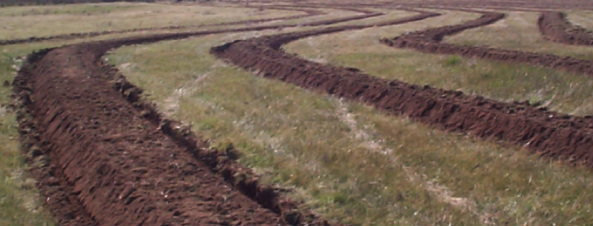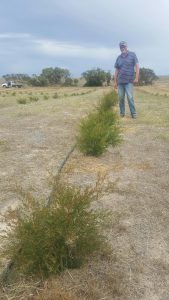
The Leptospermum species being considered here as candidates for plantation development on this website must have adequate soil moisture within the root zone leading up to and during flowering. Drought-like conditions will not only inhibit flowering potential but also severely limit the flow of nectar in the flowers.
(These kinds of conditions can be found along creek and drainage lines and in naturally low-lying areas).
The provision of irrigation will dramatically increase the range of conditions within which these plants will thrive.
In my mind, there are two types of irrigation. There is the engineered type of irrigation, and then there is the passive type of irrigation where rainfall can be harvested.
Engineered solutions will be essential for plantations planned for the arid zone where it rarely rains, and the temperatures soar in summer. Irrigation sustains the plants and can increase humidity in the foliage mass and in so doing reduce temperatures on extremely hot days. (e.g. >40C) The plants may be growing in Sunraysia or the MIA but to them, it’s the same as being in Noosa!
Irrigation can also significantly improve flowering if applied at the right time during bud development for example.
Irrigation can also be costly as well, and it cant always be assumed that there will be water of sufficient quality and quantity available to irrigate with.
Water can be applied to plantations by creating levee banks with laser levelled bays and flooding. Overhead sprinklers, ground-level sprinklers, micro-irrigation (drip) systems, and centre pivot systems all share one thing in common they cost a lot of money and should be avoided where possible.
That, of course, doesn’t apply if there is a preexisting system in place, such as would be found on a redundant irrigation farm for example, or where there are no alternatives due to a lack of natural rainfall.
Micro or drip irrigation systems, in particular, have their own set of issues that need to be considered, To begin with, the source water must be of high quality, and that will determine the level of pre-treatment and filtration required.
The system will need to be appropriately designed by an irrigation engineer, particularly on projects even approaching a commercial scale. This is to ensure the system delivers irrigation application uniformity. Undulating country adds another dimension to the design complexity.
There is also the issue of maintenance. Drip irrigation laterals running down the rows can be lifted and moved if caught up in the feet of panicked animals such as sheep or kangaroos. Strong winds can also move these light poly tubing drip lines, particularly when not filled and operating. Pinning the lines down at close intervals can go some way to solving the problem.
Foxes, in particular, are notorious for biting their way into the poly pipes to have a drink, especially in Summer. This results in a loss of overall system pressure and integrity.
Loss of pressure and having lines moved off their relatively precise irrigation targets can defeat the purpose of having it in the first place.
On the other hand, none of these obstacles is insurmountable, and the benefits of irrigation allowing for the control of soil moisture levels in the root zone can be profound.

The passive irrigation concepts involving rainfall harvesting is modelled on the well-known keyline principles. It could be applied to suitable sites that have even gentle sloping terrain up to steep terrain where it is still possible to safely put equipment on to rip and/or cultivate.
Really sandy soils, dead flat and really wet areas along with the arid zone are not candidates for this approach.
The idea is simple, and there is nothing new in it at all. The site is contour ripped and cultivated over the rip line as per the above picture. In the Summer and/or the dry months, the area between the rows will dry out and become hard so that when it does rain or there is a brief but heavy thunderstorm downpour, The rainfall will readily flow off only so far as the next rip line. Bingo! Free irrigation!
At the end of the day, it will come down to having sufficient moisture in the root zone to provide the desired result. If irrigation allows for the development of Leptospermum plantations in dry inland areas, then that is a desirable outcome. It should also be noted that these plants are very tough and forgiving compared to most horticultural crops grown with irrigation in the major inland irrigation areas in Australia.
see Developing a plantation in the drier inland regions of Australia
